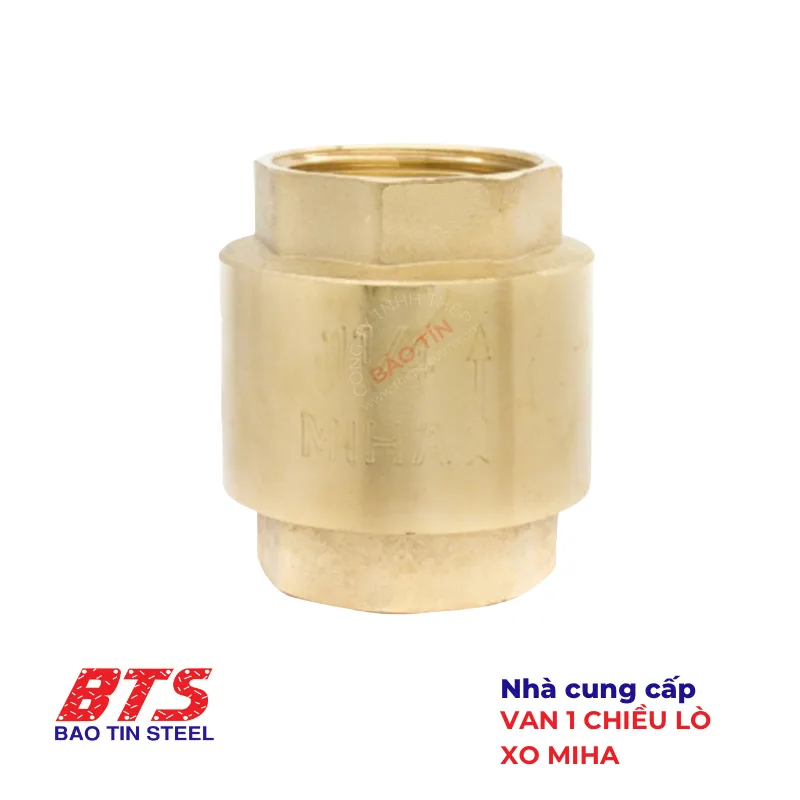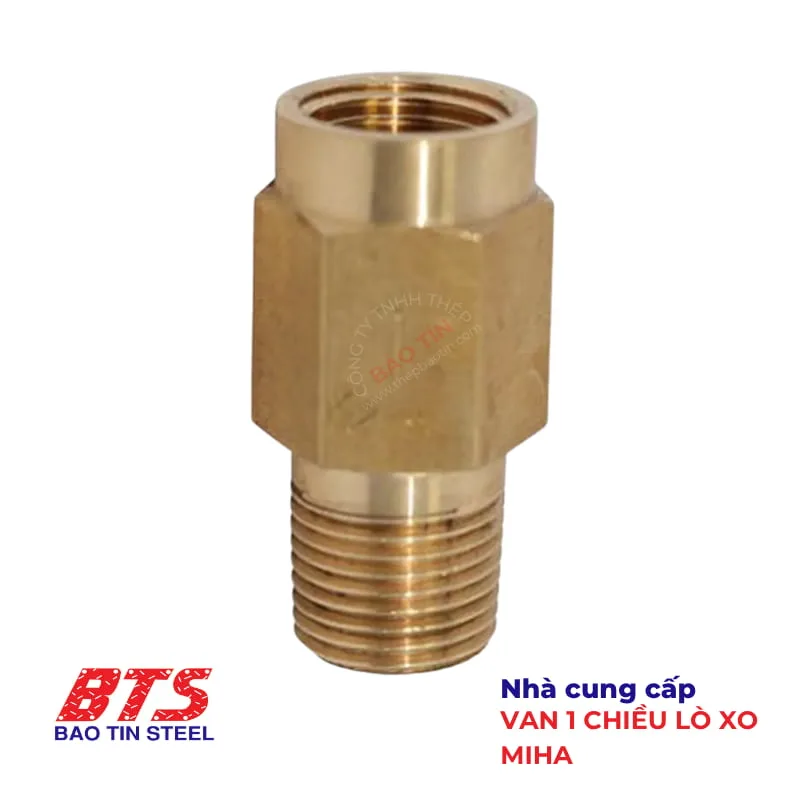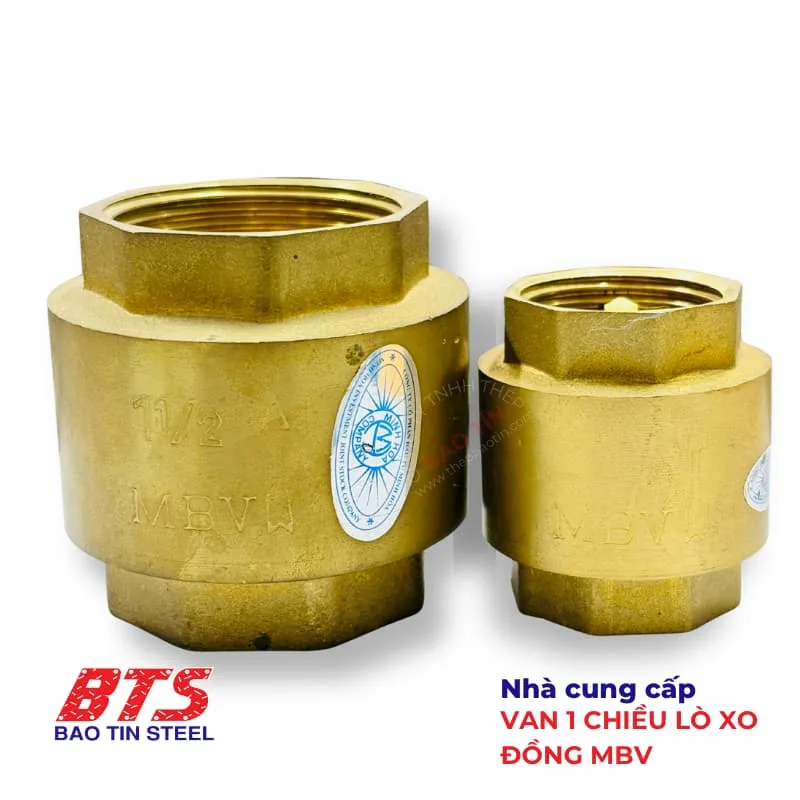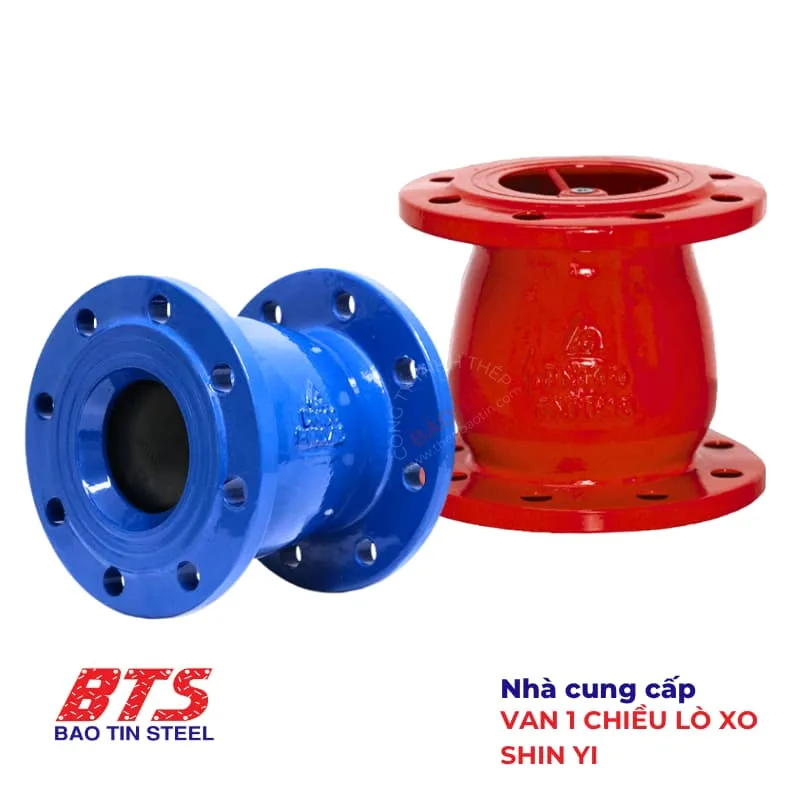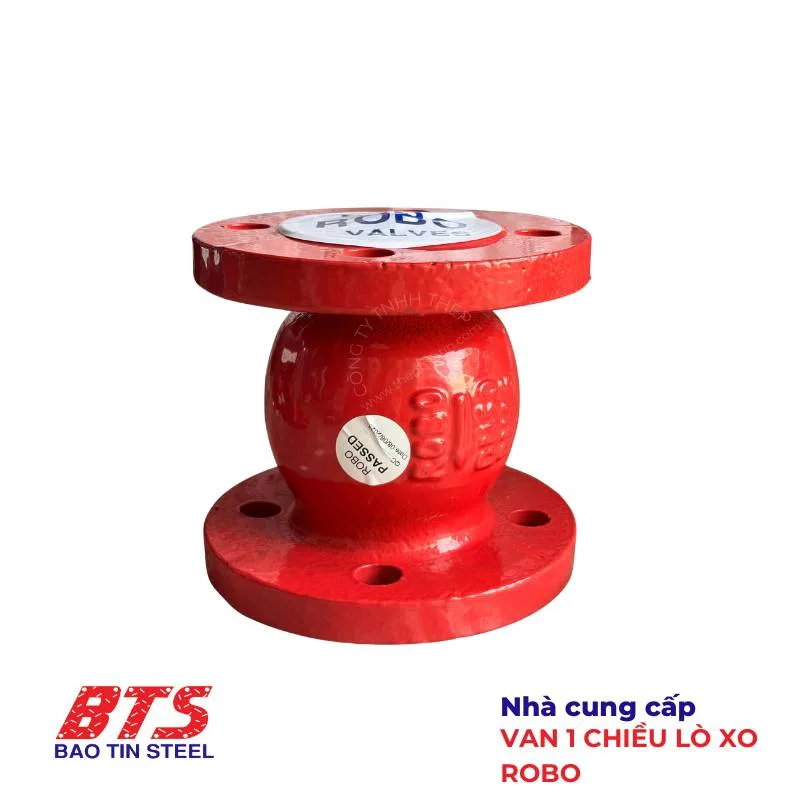Among the various types of check valves available today, spring check valves are particularly popular due to their compact design, fast closing capability, and, most notably, their ability to prevent water hammer—a common cause of damage to costly equipment. These valves are not only widely used in factories and water treatment systems, but are also increasingly found in high-rise buildings, fire protection systems, and food processing lines.
This article will help you understand what a spring check valve is, including its structure, working principle, types based on design and materials (such as plastic, stainless steel, brass, or cast iron valves), real-world applications, and a comprehensive guide on how to select, install, and maintain them effectively.
What Is a Spring Check Valve?
A spring check valve is a type of valve that prevents the reverse flow of liquids or gases in a system. What sets it apart is its automatic open-close mechanism powered by the spring’s elastic force—unlike conventional check valves that rely on gravity or flow pressure to close.

Specifically, the valve remains in a normally closed position thanks to the spring force, which keeps the disc tightly pressed against the valve seat. When the inlet pressure exceeds the spring force (known as the cracking pressure), the disc is pushed open, allowing the fluid to pass through. Conversely, when the pressure drops or reverse flow occurs, the spring immediately pushes the disc back to the closed position, preventing backflow that could damage equipment.
Thanks to its ability to close faster and more tightly than conventional check valves, the spring check valve is highly regarded for its effectiveness in preventing water hammer, reducing vibrations, and allowing for flexible installation in various orientations (horizontal, vertical, or inclined)—even in tight spaces.
Structure and Working Principle
Structure of a Spring Check Valve
While designs may vary slightly between manufacturers, a standard spring check valve typically consists of five main components:
- Valve Body: The outer casing that encloses all internal parts. It is usually made from materials such as stainless steel, brass, PVC/PP plastic, or cast iron. The body may come in threaded, flanged, or wafer-style configurations, depending on how it connects to the piping system.
- Spring: The “heart” of the valve, responsible for keeping the disc in the closed position. Springs are commonly made from stainless steel (304/316) to ensure good elasticity and corrosion resistance in wet or chemically aggressive environments.
- Disc (or Ball): When fluid pressure is strong enough, the disc is pushed away from the seat, allowing flow. Once the flow stops or reverses, the disc is immediately pushed back into the closed position by the spring.
- Seat: The surface against which the disc seals to stop reverse flow. The seat can be reinforced with materials like PTFE, EPDM, or metal, depending on the application and operating environment.
- Guide: This component ensures the linear movement of the disc, helping it open and close accurately without misalignment.

Structure of spring check valve
Detailed Working Principle
A spring check valve operates fully automatically, based on the pressure differential between the inlet and outlet sides of the valve:
- Normal flow (left to right):
When the inlet pressure increases and exceeds the spring force, the disc is pushed away from the seat → the valve opens → liquid or gas flows through. - When flow stops or begins to reverse:
As the flow pressure drops, the spring pushes the disc back to its original position → the disc presses tightly against the seat → the valve closes → backflow is prevented.
Because it uses a spring, this type of valve responds quickly, is not affected by gravity, and can be installed both horizontally and vertically. It is ideal for horizontal, inverted, or confined space installations.
In systems requiring quick opening and closing and minimizing the “water hammer” effect, the spring check valve is an extremely effective choice due to its fast and secure closing mechanism.
Classification of Spring Check Valves
Classification of spring check valves by construction
Each type of construction offers its own advantages, suitable for specific applications and installation spaces. Below are the common types of valves:

In-line Check Valve
- A linear-type valve with flow passing straight through the valve body.
- The spring is positioned along the axis, and the disc opens in the direction of the flow.
- Suitable for both horizontal and vertical installations, occupying minimal space.
- Applications: clean water systems, HVAC, fire protection (PCCC).
Ball Check Valve
- Uses a round ball as the valve disc, combined with a spring to seal tightly.
- When pressure is applied, the ball is pushed off the seat—allowing flow.
- When the flow stops, the spring pushes the ball back to the closed position.
- There are foot valve types that integrate a strainer, used at pump inlets.
Lift Check Valve
- The valve disc lifts vertically when flow is present.
- When the flow stops, the disc falls and is assisted by the spring to close.
- Works well with gases, steam, and liquids.
- Commonly used in boilers, compressed air systems, and vertical piping.
Axial Flow Silent Check Valve
- Designed to effectively reduce noise and water hammer.
- Flow passes through a narrow gap around the central disc, allowing smooth opening/closing.
- Used in high-rise buildings, chemical plants, and clean water systems.
- Higher cost but offers long service life and high performance.
Y-loaded Valve
- Y-shaped design, with the valve disc positioned diagonally and easy to access for maintenance.
- Allows on-site inspection and servicing without removing the valve from the pipeline.
- Widely used in food processing, chemical, and water treatment industries.
Foot Valve
- Installed at the pump suction to retain water and prevent debris from entering the pump.
- Integrated with a strainer to protect the pump from trash, leaves, and sand.
Commonly used for bore wells, fish ponds, and swimming pool pumps.
Wafer Check Valve
- Slim design clamped between two flanges, saving space.
- The valve disc may be double-wing, single-leaf, or have a central spring.
- Suitable for systems with limited space: HVAC, fire protection (PCCC), and water treatment.
Classification of Spring Check Valves by Material
Material determines the valve’s durability, pressure and temperature resistance, chemical compatibility, and overall cost:

Plastic Spring Check Valves (PVC, PP, PVDF)
- Lightweight, non-corrosive, and highly resistant to chemicals.
Suitable for mildly corrosive environments, clean water, and wastewater systems.
Operates at lower temperatures (~60–80°C).
Affordable and easy to install.
Stainless Steel Spring Check Valves (304/316 Stainless Steel)
- High heat and pressure resistance with excellent corrosion protection.
Used in steam, seawater, chemical, food, and pharmaceutical applications.
Higher cost, but long service life—ideal for harsh environments.
Brass Spring Check Valves (MIHA)
- Common in domestic water systems, home pumps, and air conditioning.
Good corrosion resistance, reasonably priced, and easy to replace.
Not suitable for environments with strong chemicals.
Below are some MIHA brass spring check valve models available at Bao Tin Steel:
Cast Iron Spring Check Valves
- Traditional material with good mechanical strength and low cost.
- Used in large-scale water supply and drainage systems, and fire protection systems.
- Requires anti-corrosion coating when used in humid or corrosive environments.
Below are some cast iron spring check valve models available at Bao Tin Seel:
Outstanding Advantages of Spring Check Valves
Compared to traditional types of check valves—such as swing check valves, non-spring ball valves, or flap check valves—spring check valves offer significant advantages, especially in systems that require fast response, water hammer protection, and flexible installation. Below are the key benefits you should consider:
Fast closing to effectively reduce water hammer:
- The spring mechanism allows the valve to close immediately when flow stops or reverses—much faster than gravity-reliant swing check valves. This helps reduce pressure shocks, minimise noise, and protect pumps and pipelines from damage caused by water hammer.
Stable operation in multiple installation orientations:
- Unlike valves that rely on gravity, spring check valves can operate efficiently whether installed horizontally, vertically upwards, or vertically downwards. This flexibility is ideal for tight or complex piping layouts.
Compact size, space-saving design:
- Many spring check valve types—such as wafer or in-line models—feature a slim, lightweight design, making them ideal for use in technical cabinets, compact pump stations, or high-rise piping systems where space is limited.
Low maintenance, long-lasting durability:
- Simple yet effective structure with no need for power or external controls. Springs are made of corrosion-resistant stainless steel, and discs/gaskets can be made from chemical-resistant materials—offering extended service life and reduced maintenance costs.
Compatible with various media and pressure ranges:
- Depending on the material (plastic, brass, stainless steel, etc.), spring check valves can handle clean water, seawater, chemicals, compressed air, steam, and more—across a wide range of pressures, from residential to heavy industrial use.
High performance at a reasonable cost:
- For the same price point, spring check valves typically offer better flow efficiency and sealing performance, with lower energy loss compared to swing or globe check valves.
Real-World Applications of Spring Check Valves
Thanks to their fast response, effective backflow prevention, and flexible installation options, spring check valves are widely used across various technical systems—from residential setups to heavy industrial operations. Below are some common applications you may frequently encounter:

Typical Applications of Spring Check Valves
1. Domestic Water Supply & Drainage Systems
In apartment buildings, high-rises, and villas
- Commonly installed after water pumps to prevent backflow into storage tanks or pumps.
- Brass spring check valves and MIHA valves (a trusted Vietnamese brand) are widely used here due to their durability and affordable cost.
2. Wastewater & Chemical Treatment Plants
- Plastic spring check valves (PVC, PP, PVDF) are widely used in wastewater treatment systems, settling tanks, filtration units, and light chemical pipelines.
- For strong chemicals or harsh environments, 316 stainless steel spring valves are the ideal choice.
3. Fire Protection Systems (PCCC)
- Used in wall-mounted fire hydrants and sprinkler systems.
- Flanged cast iron spring check valves or wafer-type spring check valves are typically applied in large pipelines under high pressure.
4. Compressed Air and Steam Systems
- Spring check valves prevent backflow of gas or steam that could cause pressure shock to compressors or boilers.
- 304/316 stainless steel spring check valves are the optimal choice for industrial plants, autoclaves, and industrial drying systems.
5. Well Pumps, Pools, and Fish Tanks
- Foot valves (spring-loaded) are installed at the suction end to prevent water from flowing back when the pump is off, keeping the pipe filled to avoid dry running.
- These valves often come with an integrated strainer, protecting pumps from sand, leaves, and debris.
6. Building and Industrial Water Supply Systems
- In systems using booster pumps or requiring a continuous water supply, spring check valves help stabilise pressure and prevent pressure surges.
- Wafer-type spring check valves are favoured for their compact design, making them easy to replace and maintain in narrow technical cabinets.
How to Choose the Right Spring Check Valve
To ensure system stability, reduce maintenance costs, and prevent critical issues like water hammer, leaks, or pressure drops, users need to carefully consider the following criteria when selecting a spring check valve:
Select Based on Valve Body Material
Depending on the working environment and type of fluid, you should choose a suitable material:
| Working Environment | Recommended Spring Valve Material | Suggestion |
|---|---|---|
| Domestic clean water | Brass | Brass spring check valve, MIHA |
| Light chemicals, wastewater | Plastic (PVC, PP, PVDF) | Plastic spring check valve |
| Strong chemicals, seawater | Stainless steel 316 | Stainless steel spring check valve |
| Large industrial systems | Coated cast iron or stainless steel | Flanged cast iron spring check valve |
Note: In corrosive environments or high-temperature conditions, always prioritise 316 stainless steel valves to ensure durability and tight sealing.
Select by Pipe Connection Type
- Threaded spring check valves: Easy to install, suitable for small pipes (DN15–DN50).
- Flanged spring check valves: Secure connection, used in high-pressure systems and large pipes (DN65 and above).
- Wafer valves (sandwiched between two flanges): Compact and space-saving, commonly used in fire protection (PCCC) and HVAC systems.
- Clamp or welded valves (for food/pharmaceutical applications): Require high cleanliness standards and quick disassembly.
Select by Cracking Pressure
Cracking pressure is the minimum pressure required to open the valve. Choosing the wrong cracking pressure can cause the valve to:
- Fail to open under low flow pressure
- Open slowly → resulting in pressure drop and water hammer
- Cause chatter (rapid opening and closing)
It’s recommended to consult the manufacturer’s specifications or seek advice from a technician to select a spring with the appropriate force for the actual flow conditions.
Select by Installation Orientation
- Horizontal installation: Suitable for most types of spring check valves (threaded, wafer, flanged, etc.).
- Vertical installation (upward or downward): Requires valves with springs strong enough to prevent the disc from shifting when pressure drops.
- For special systems, it’s best to choose specialised valves with customised springs.
Select by Reputable Brand and Certifications
Some highly regarded brands on the market today include:
- MIHA – Good quality Vietnamese brand with reasonable prices
- Samwoo, Wonil (Korea) – Durable, popular in large projects
- Kitz (Japan), AUT, Shin Yi (Taiwan) – High performance, complete CO/CQ (Certificates of Origin/Quality)
- Chinese brands – Low cost, but it’s best to choose distributors with a good reputation to avoid poor-quality products
Installation and Maintenance Guide for Spring Check Valves
To ensure spring check valves operate efficiently, last long, and avoid issues such as leaks, water hammer, or unstable opening/closing, it’s essential not only to choose the right valve but also to install it correctly and perform regular maintenance.
The following guidelines will help you implement proper procedures right from the start:

Spring Check Valve Installation Guide
Step 1: Identify the Correct Flow Direction
- There is always an arrow on the valve body indicating the flow direction.
- Installing the valve backwards is a common mistake that can cause the valve not to open or damage the valve disc.
Step 2: Prepare Clean Flanges or Threads
- Clean both pipe ends before installation.
- Ensure no debris, leftover pipe glue, plastic fragments, etc., that could jam the valve disc or cause leaks.
Step 3: Install the Valve in the Appropriate Position
- Stainless steel, brass, and MIHA spring check valves can be installed horizontally or vertically (if the spring is strong enough).
- For vertical installation with downward flow, ensure the valve is designed for that orientation.
Step 4: Tighten Evenly and with the Correct Torque
- For flanged valves: tighten bolts symmetrically at 4–6 points in a star pattern to avoid misalignment.
- For threaded valves: apply thread seal tape properly, tighten by hand with moderate force, avoiding over-tightening, which can crack the valve body.
Step 5: Post-Installation Check
- Slowly open the water flow to verify smooth valve operation.
- Check for leaks, chatter (rapid opening/closing), or any sealing issues.
Spring Check Valve Maintenance Guide
- Although spring check valves are generally low-maintenance devices, regular inspections are necessary to ensure stable operation:
Perform maintenance every 3 to 6 months (depending on the working environment).
| Inspection Item | How to Perform | Notes |
|---|---|---|
| Check for leaks | Observe joints and around the valve body when under pressure | If leaking, check or replace seals |
| Smoothness of opening/closing | Test valve operation by flowing fluid—listen for noise or vibration | Could indicate chatter |
| Clean the interior | Remove the valve (if necessary) and clear debris or dirt stuck in the disc/spring | Especially important for foot valves |
| Check spring elasticity | Press lightly on the valve disc to feel spring tension | If too weak → replace spring or entire valve |
Note: Do not use strong chemicals or sharp objects for cleaning to avoid damaging the valve seat surface or seals.
Common Issues & Troubleshooting
| Symptom | Cause | Solution |
|---|---|---|
| Valve makes a rattling noise | Valve too large for flow rate → rapid opening/closing (chatter) | Switch to a smaller valve or reduce cracking pressure |
| Water flows backwards | Weak spring or debris stuck on the valve disc | Disassemble, clean, and check the spring |
| Valve doesn’t open | The flow pressure is insufficient to overcome the spring force | Check cracking pressure; consider replacing with a lighter spring |
| Slight water leakage | Seal gap, misalignment, or worn contact surface | Clean, realign, or replace the seal as needed |
Conclusion
The spring check valve is not just a simple device to prevent backflow — it is a silent yet crucial “gatekeeper” in every piping system. Thanks to its flexible spring-operated design, the valve helps reduce water hammer, minimise leaks, operate smoothly, and enhance the overall safety of the system.
Depending on the working environment and technical requirements, you can easily choose among plastic spring valves, stainless steel valves, brass valves, or MIHA valves — each offering its own advantages in durability, pressure resistance, and investment cost.
At Bao Tin Steel, we provide a full range of genuine spring check valves with complete CO/CQ documentation, competitive prices, and expert consultation to help you select the right valve for every project — from residential to industrial applications.
- Hotline: 0932 059 176
- Email: bts@thepbaotin.com


 Tiếng Việt
Tiếng Việt ភាសាខ្មែរ
ភាសាខ្មែរ